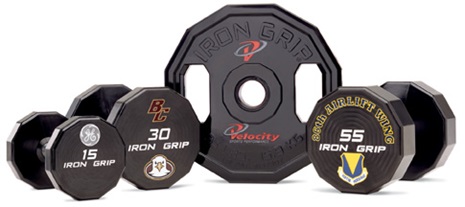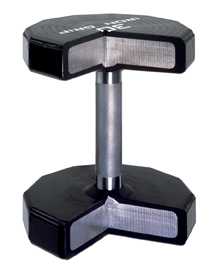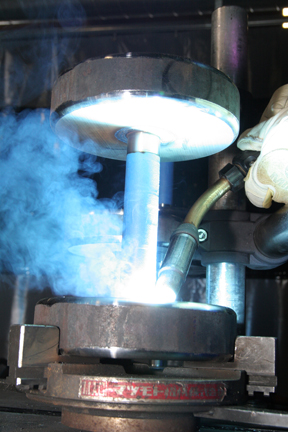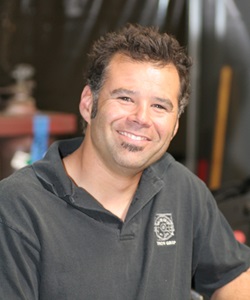Executive Summary:
- Millermatic 350P offers high weld quality, excellent bead appearance.
- Workflow is increased by as much as four minutes per part due to lack of spatter and associated precautions/clean-up.
- Easy, straight-forward controls and built-in programs simplify operation and make Pulsed MIG easy to learn.
- The new machines paid for themselves within four months thanks to increased
Worth the Weight-Pulsed MIG Comes of Age
Pulsed MIG units increase productivity 16%, reduce scrap by 20% and pay for themselves in 4 months.
You may be tempted to think that all weight sets are created equal. After all, how much difference can there be? A weight is a weight, right? Wrong. Turns out, there’s quite a bit of difference, and when top health clubs, professional sports teams, corporate fitness centers, U.S. Armed Forces and other institutions need free weights, the majority turn to Iron Grip Barbell Company of Santa Ana, Calif.
Scott Frasco and Michael Rojas founded Iron Grip in 1993, introducing weight plates that featured integrated handgrips and a unique 12-sided design, which represented a significant improvement to one of the oldest pieces of fitness equipment. Other products, including maintenance-free solid dumbbells, followed, and Iron Grip continued to grow with a commitment to innovation and quality. Now, with a workforce of 65 people and annual sales in excess of $14 million, Iron Grip offers more than 10 product lines with more than 1,000 different items.
Iron Grip is the largest provider of commercial free-weight equipment worldwide and the only manufacturer with a line of exclusively American-made free-weight equipment. Iron Grip recently reexamined its tried and proven manufacturing process. By upgrading from conventional MIG welders to Millermatic 350P pulsed MIG welders, Iron Grip increased production by about 16 percent, reduced scrap even more and removed a potential source of weld defects.
Both Iron Grip’s dumbbells and fixed barbells are assembled from precision-machined steel bars and drilled, chamfered and precision-machined heads, and then welded together for durability and safety. They are available both in painted steel (“Some people want to hear the clang of steel,” Frasco says) and steel encapsulated in durable, heavy-duty Urethane, so the dumbbell will not scuff or damage equipment, walls or floors.
Why Weld?
“We elected not to go with bolting because bolts will eventually come loose,” says Winter Douglas, Manufacturing Engineer, Iron Grip. “If you’ve been in a gym that uses the bolt design, you’ve probably dealt with a dumbbell that is a little shaky, loose or that rattles. It needs to be tightened every so often. A properly designed weld joint, however, is going to be stronger than a bolt. Plus, you don’t have to worry about a welded dumbbell coming loose.”
 |
|
| When top health clubs, corporate fitness centers, U.S. bases and other institutions need maintenance-free free weights, they turn to Iron Grip Barbell Co.. The user doesn't have to worry about a welded dumbbell coming loose.
|
|
 |
The result is maintenance-free equipment that, according to Douglas, has a much lower failure rate than Iron Grip’s competitors–an important consideration since no one wants to pay for shipping weights across the country. The bolted design isn’t terrible, Douglas says, but organizations don’t want to deal with the maintenance they require.
Iron Grip’s dumbbells range from 5 to 150 pounds, with up to 200 lb. dumbbells available as a special order. Iron Grip uses high quality steel throughout to achieve the best welding results and a patented design for attaching bars to heads. Handles are pressed with a 30 ton hydraulic press into a flat ring around the base of the dumbbell. This, Frasco explains, moves the weld away from the handle and greatest stress point, which eliminates a potential source of failure. A 45-degree fillet weld from head to handle has the potential to create a heat-affected zone at the top of the weld, which is the greatest stress point in a dumbbell and could be a source of failure under high stress.
Once the handle is pressed into the weight, the assembly is placed on a turntable, which allows the welders to make a continuous weld around the circumference while maintaining the same gun angle. The operator controls rotation by use of a foot pedal.
Douglas designed the turntable and procedure after he saw another company use multiple welds to get around a circumference–the part stayed stationary while the welder moved.
“To me, that’s crazy,” Douglas says. “Why would you even waste your time? You’ve got to start and stop, and if you’re going to do it two and even three times to make one weld, you have all these factors–gun and hoses that can tangle, changing position–that affect welding effectiveness.”
 An arm rest supports the operator’s arm while a turntable turns the part in place. Winter Douglas designed the turntable to eliminate a potential source of variability.
An arm rest supports the operator’s arm while a turntable turns the part in place. Winter Douglas designed the turntable to eliminate a potential source of variability.
One of Douglas’s goals is to remove guesswork and variability that can lead to imperfect welds, both for aesthetic and reliability reasons.
“Iron Grip equipment has to shine,” Douglas says. “The dumbbell has to look beautiful so that everyone wants to put their hands on it the moment it gets on the gym floor. It may get scuffed up during use, but until that point, I want it to look perfect. It’s very important to us.”
But the importance of a solid, smooth weld goes beyond cosmetic perfection. Dumbbells are subject to repeated stress and an improper weld could lead to a spot where stress can focus and start to crack.
“It is critical to make sure that we have a nice, smooth transition where we aren’t going to have a problem in cracks developing around a certain spot,” said Douglas.
“Any time you have a flaw or an area where the stress has the ability to focus, that’s going to cause a stress riser,” according to Mike Cunningham of Cameron Welding Supply (http://www.cameronwelding.com/), Iron Grip’s welding distributor with five locations in Southern California. “It can be as simple as a nick in a part where the stress can accumulate or a weld without a smooth transition where the stress forces can gather at that one crevice or point. Having a smooth transition allows the stress to move completely through the entire dumbbell and not focus in one part.”
“What we’re looking for is a nice flat, even, smooth weld that grabs to both sides and looks seamless,” Douglas says. Anything less will lead to the part being scrapped.
Short circuit’s Limitations
Until recently, Iron Grip welders used a short-circuit welding process, which allowed them to produce the high quality, aesthetically pleasing welds for which Iron Grip is known. However, it necessitated the application of anti-spatter material and occasionally scrapping a part because of weld flaws.
 |
|
Pulsed MIG is a spray transfer process that eliminates spatter. New technology, such as in the Millermatic 350P, has made it easier to achieve high quality welds.
|
"The short circuit process held several disadvantages for Iron Grip,” says Cunningham. “During the short circuit transfer process, the weld wire shorts to the base material 60 to 120 times a second. Each time the wire shorts to the work, excess wire burns off and particles are blown away from the welding arc. These particles are not part of the final weld and are know as spatter.”
To control the spatter, Iron Grip welders would tape the handles and apply anti-spatter material with either a brush or a rag. Operators then welded the part and, because it was too hot too handle, would set it aside until it was cool enough for them to remove the anti-spatter and masking tape.
These pre- and post-weld steps could add four minutes to the production of each dumbbell–more if the operator had to remove spatter that still occurred despite the precautions. In addition, Douglas estimates that when using the short circuit process, at least two parts would be scrapped each day due to an imperfect weld.
“The difficult part is if you scrap one half, you’ve scraped the part, so one bad weld would cause us to scrap the entire dumbbell,” Douglas says. “I’m not going to try and salvage it to sell to a customer. A good part requires two flawless welds and there’s really no in-between.”
While the time spent for the application of anti-spatter and the scrap rate were at acceptable levels, Douglas continued to explore alternatives to improve the process. His research led him to pulsed MIG, a modified spray transfer method in which current pulses between peak and low background levels. During the high peak current, metal is sprayed across the arc. During the background level of the cycle, the puddle is allowed to cool. It eliminates the continual shorting of the wire and associated spatter that occurs in short circuit transfer. Instead, pulsed MIG promised to give a very flat, smooth appearance–exactly what Douglas was looking for.
Unfortunately, Douglas’ first foray into pulsed MIG welding didn’t produce the desired results. The machine was complicated to use and the experts he turned to couldn’t get the pulse program to work up to Iron Grip standards. Until relatively recently, this was typical of pulsed MIG power sources.
“When the first pulsed MIG machines came out, they were so complicated that a lot of welders shied away from using them,” says Cunningham, “You had to set the pulse width, the frequency, the background current–the average welder really couldn’t use it.”
Pulsed MIG Grows Up
“Everyone told me how good pulse was, yet I spent a lot of money to get a machine and yet we couldn’t get it to work,” Douglas says. Undaunted, Douglas turned to the Web for his research and found a possible solution: Miller Electric’s Millermatic 350P. With this unit, pulsed MIG welding seemed to have come of age.
 |
| “A good part is a good part and there’s really no in-between,” says Winter Douglas, Iron Grip manufacturing engineer, who chose the Millermatic 350P.The Millermatic 350P pulsed MIG welder offers a choice of built-in programs and the ability to fine tune parameters. Iron Grip achieved top quality welds within their first two hours with a 350P and rarely needs to change settings.
|
The unit offered 300 amps with a 60-percent duty cycle. It looked easy to use; only two control knobs gave complete access to its built-in pulsed MIG programs, as well as the flexibility to fine tune the parameters if he desired. Two large digital displays relayed the information in an easy-to-read format. Plus, case studies on MillerWelds.com showed that the unit was operator friendly and gave consistently high quality welds.
Douglas was, however, still leery after his first foray into pulsed MIG welding and asked Cunningham and Miller district manager Ed Bogner for a demonstration. Douglas showed up for the demo bringing dumbbell components with him.
Within two hours, they were making production quality welds that met Iron Grip’s standards.
“I’m glad we produced acceptable parts quickly because we started out with the ten-pound weights, by the time we got the thing dialed in, we were up to 25-pounders,” said Cunningham. “I figured, we better get this dialed in pretty fast, otherwise we’re going to get too tired to finish.”
“One of the key things we were able to do the first time we tried the 350P was to produce a beautiful, flat, nice smooth weld without stress risers in it,” Douglas says. “We didn’t improve the quality, because we always had very high standards, but production and efficiency is completely different. It’s much easier and quicker to achieve the same result.”
Peace of Mind
Douglas bought two of the machines and overnight eliminated the need for anti-spatter, along its the associated application time and clean-up and cool down times. Plus, as Douglas notes, it eliminated another variable because there was no longer any worry whether too much or too little of the material was being applied.
“Previously, we averaged 168 dumbbells per shift,” says Douglas. “At our best, we hit 180 a day. Now we average 206 per shift. The actual increase in productivity is 16.5 percent, and we reduced the scrap rate by 20 percent. The people and material were the same. Only the welding units are different.”
Assuming an hourly rate of $20, saving 16.5 percent on 16 hours of machine time per day translates into a savings of $52.80 per day. At that rate, each Millermatic 350P paid for itself in 77 work days, or about 4 months. This does not take into consideration the 20% savings in scrap, or Douglas’ increased peace-of-mind.
“There are a lot of elements involved in achieving a good weld,” Douglas says. “Defects can come from a weld that’s too hot or too cold or from welding two dissimilar metals that flex at different rates, or by joining a large head to a small diameter handle. Our design minimizes those possibilities, but still the weld was a potential problem spot. With the previous machines the operator needed to be more trained and more cautious when they welded.
“Now I really have peace-of-mind and I don’t have to worry about whether or not the operators are doing what they’re supposed to do or if the weld is a little hot or the weld is a little cold, or if I have one that might crack rather than bend when it drops. After the first day, we haven’t had anything other than minor adjustments. It’s just the machine in the corner that they forget about it until it runs out of wire.”
While steel prices are volatile, Iron Grip strives to maintain its prices, and the Millermatic 350P helps them accomplish that.
“The only way to maintain prices and not pass every price increase to our customers is to make production as efficient as I can,” comments Douglas. “There’s really no other way, so we have to use equipment that we can rely on, and that I think is fool-proof. The Millermatic 350P is the do-all easy guy. It really does it all well, and if we had a need for more welders, that would be the machine I would buy again, without a doubt.”